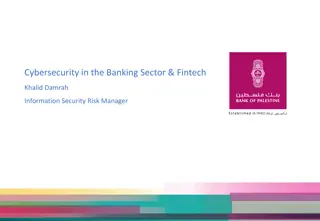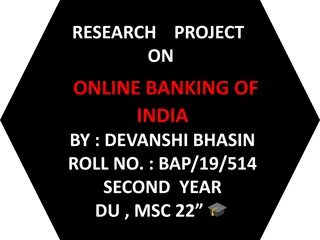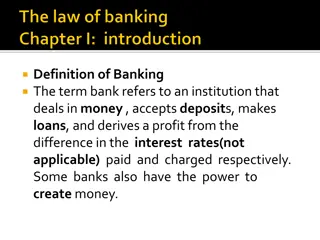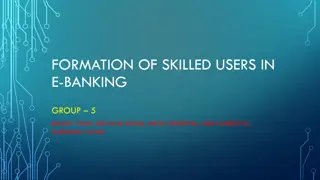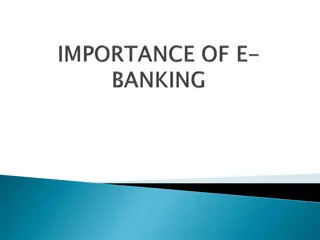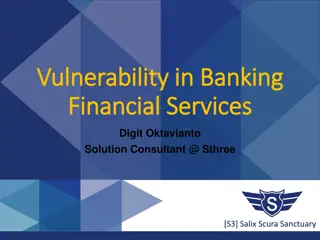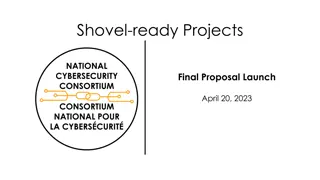Online Banking and Cybersecurity: Understanding Risks and Security Solutions
Explore the evolution and benefits of online banking, along with the associated risks like data breaches and cyber theft. Learn about cybersecurity measures, including data encryption and authentication protocols, to safeguard sensitive financial information in online banking transactions.
Download Presentation

Please find below an Image/Link to download the presentation.
The content on the website is provided AS IS for your information and personal use only. It may not be sold, licensed, or shared on other websites without obtaining consent from the author. Download presentation by click this link. If you encounter any issues during the download, it is possible that the publisher has removed the file from their server.
E N D
Presentation Transcript
Presentation on ONLINE BANKING AND CYBER SECURITY CONCERNS
UNDERSTANDING & INTRODUCTION TO ONLINE BANKING History of Online Banking Online banking dates back to the 1980s with the introduction of telebanking and ATMs. Types of Online Accounts Online banking accounts can include checking, savings, mortgages, and investment accounts. Advantages of Online Banking Convenience, accessibility, and real-time transaction monitoring are key benefits of online banking. Convenience of Access Online banking offers 24/7 access to account information and transaction capabilities. Digital Transactions It involves carrying out bank transactions through the internet using electronic devices such as smartphones, tablets, or computers. Virtual Banking Features Includes features such as fund transfers, bill payments, and account management via the internet.
EVOLUTION OF ONLINE BANKING Shift to Digital Platforms Emergence of Mobile Banking Integration of Fintech Solutions Online banking has evolved from The proliferation of smartphones led Online banking has embraced fintech basic account viewing to to the development of mobile innovations, such as AI, blockchain, sophisticated digital platforms banking apps, transforming the and biometric authentication, for offering extensive financial services. banking experience. enhanced security and convenience.
RISKS ASSOCIATED WITH ONLINE BANKING Data Breaches Sensitive customer information is at risk of being compromised through data breaches, leading to financial loss and identity theft. Phishing and Fraudulent Activities Online banking users are susceptible to phishing scams and fraudulent activities aimed at obtaining sensitive account information. Cyber Theft and Identity Fraud Theft of funds and identity fraud are potential risks associated with online banking, necessitating robust security measures. Financial Fraud Online banking is vulnerable to financial scams such as unauthorized transactions and account takeovers.
UNDERSTANDING CYBER SECURITY Cyber Threat Landscape Data Encryption Techniques Advanced encryption techniques are crucial for Understanding the evolving cyber threat landscape is securing sensitive financial data transmitted through essential for implementing effective security strategies online banking channels. in online banking. Authentication Protocols and App permissions Implementing robust authentication protocols helps verify the identity of users accessing online banking services.
COMMON CYBER THREATS IN ONLINE BANKING Malware Attacks Malicious software is used to infiltrate online banking systems, leading to financial fraud and data theft. Social Engineering Tactics Cybercriminals employ social engineering to manipulate users into disclosing sensitive financial information. Ransomware Incidents Ransomware poses a significant threat to online banking systems, causing financial disruptions and data extortion. Phishing Scams & OTP Bypass Phishing involves fraudulent attempts to obtain sensitive information such as usernames, passwords, and credit card details.
BANKING MALWARES Fin-CERT, Banks, LEAs, Regulators
*PHISHING AND SOCIAL ENGINEERING Fraudulent Schemes Understanding and identifying deceptive tactics used in phishing Psychological Manipulation and social engineering schemes to deceive online banking users. Exploring the psychological tactics Email and employed by cybercriminals to Communication Risks manipulate individuals into Recognizing the risks associated with divulging confidential information. fraudulent emails and deceptive communications designed to exploit online banking users.
CREDENTIAL HARVESTING WITH PHISHING HOW DOES IT WORK?
SOCIAL ENGINEERING: LOVE, GREED, FEAR Loan SMS - Harassment
OTP BYPASS Remote Control 2 Mobile Application 1 Phishing Real Time OTP 4 3 Call based OTP Theft OTP over email 5 Mobile Number Update 6 Call Conference Based 7
SECURITY MEASURES IN ONLINE BANKING Biometric Authentication Biometric verification methods, such as fingerprint and facial recognition, bolster the security of online banking transactions. Multi-factor Security Employing multiple authentication factors, such as passwords and OTPs, enhances the security of online banking systems. Secure Server Infrastructure Robust server infrastructure with encryption and firewalls forms the foundation for secure online banking operations. Encryption Protocols Utilizing secure encryption protocols to protect sensitive data during online transactions and communications. Firewall Protection Implementing firewalls to prevent unauthorized access and intrusions into the online banking system. Regular Security Updates Frequent updates to security systems and software to address vulnerabilities and strengthen defenses against cyber threats.
MULTI-FACTOR AUTHENTICATION Role in Enhancing Security Implementing additional layers of identity verification to prevent Types of Authentication Factors unauthorized access and account breaches. Factors include knowledge (passwords), possession (phones), and inherence (biometrics), Integration in Online reinforcing online banking security. Integration of two-factor Banking authentication is essential for mitigating unauthorized access and enhancing the security of online banking platforms.
ROLE OF ENCRYPTION IN ONLINE BANKING Encryption Mechanisms Utilizing strong cryptographic algorithms ensures the confidentiality and integrity of sensitive financial data in online banking. Secure Data Transmission Encryption facilitates secure transmission of financial information over digital channels, safeguarding it from unauthorized interception. Importance of SSL Certificates SSL certificates are vital for establishing a secure connection between users' browsers and online banking servers, preventing data breaches. Cryptographic Algorithms Implementing robust cryptographic algorithms to secure data and communications in online banking systems. Protection against Unauthorized Access Encryption serves as a barrier against unauthorized access, ensuring that only authorized parties can interpret the data.
BEST PRACTICES FOR SAFE ONLINE BANKING Secure Password Management Adopting strong, unique passwords and regularly updating them is critical for safeguarding online banking accounts. Regular Account Monitoring Frequent monitoring of account activities helps detect and prevent unauthorized transactions or suspicious behavior. Software and Security Updates Regularly updating software and security applications mitigates vulnerabilities and strengthens online banking security. Security Awareness Education Educating online banking users about cybersecurity best practices and potential risks to foster a security-conscious mindset.
REGULATIONS AND COMPLIANCE IN ONLINE BANKING Compliance Requirements Online banking institutions must adhere to regulatory requirements to ensure the security and integrity of financial transactions. Anti-Money Laundering (AML) Implementing AML practices mitigates the risk of illegal financial transactions and enhances the security of online banking systems. Data Privacy Regulations Adhering to data privacy laws safeguards customers' personal and financial information, promoting trust in online banking services.
CASE STUDIES OF CYBER SECURITY BREACHES Impact on Financial Institutions Cybersecurity breaches have significant repercussions, including Lessons Learned financial losses, reputational damage, Analyzing cyber breach case studies and customer distrust. enables institutions to identify vulnerabilities and strengthen their Addressing Customer Concerns online banking security measures. Effectively addressing customer concerns following security breaches is key to rebuilding trust and maintaining clientele.
FUTURE TRENDS IN ONLINE BANKING SECURITY Adoption of Biometric Technologies Blockchain for Secure Transactions Increased use of biometric Leveraging blockchain technology will authentication and identification will enhance the transparency, security, redefine the security landscape for and immutability of online banking Role of AI in Cybersecurity online banking. transactions. AI applications will play a pivotal role in predicting and preventing cyber threats, augmenting online banking security measures.
CONCLUSION Risk Mitigation Strategies Constant Vigilance Continuous monitoring and Implementing robust security proactive adoption of security measures and compliance with technologies are essential to Customer Education and Trust regulations is imperative for safeguard the integrity of online mitigating online banking risks. Educating customers about online security best banking. practices and building trust are fundamental for sustainable online banking operations. Continuous Adaptation Recognizing the need for ongoing adaptation and improvement of security measures to address evolving cyber threats in online banking.

 undefined
undefined























